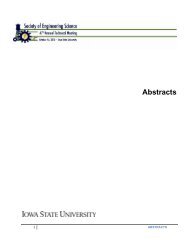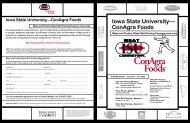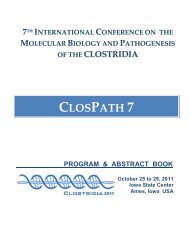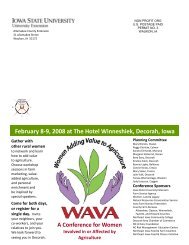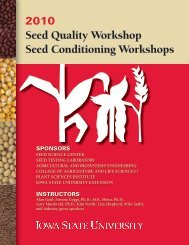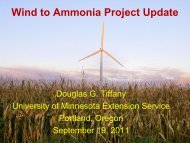Firth Whitehouse - Conference Planning and Management
Firth Whitehouse - Conference Planning and Management
Firth Whitehouse - Conference Planning and Management
You also want an ePaper? Increase the reach of your titles
YUMPU automatically turns print PDFs into web optimized ePapers that Google loves.
Underst<strong>and</strong>ing Our Food System:<br />
An Applied Research Perspective<br />
<strong>Firth</strong> K. <strong>Whitehouse</strong>, Ph.D.<br />
ISU Extension <strong>and</strong> Outreach Annual <strong>Conference</strong><br />
October 24, 2012 Ames, Iowa
Our world is big…<br />
̴7,000,000,000 ̴312,800,00 ̴3,077,000<br />
̴4.5% of global<br />
population<br />
̴0.04% of global<br />
population<br />
US Census Bureau, USDA ERS, 2012
…but in terms of our global food system,<br />
our world is actually very small<br />
ACTIVITIES that we engage in here in Iowa<br />
directly influence how our global food<br />
system functions
Examples of food system activities in Iowa:<br />
• Growing/harvesting crops<br />
• Raising/hunting animals, birds <strong>and</strong> fish<br />
• Processing <strong>and</strong> packaging food<br />
• Using water<br />
• Regulating food<br />
• Distributing food<br />
• Selling food<br />
• Preparing food<br />
• Eating food<br />
• Wasting food<br />
• Conducting research related to food
Courtesy of John Ingram, Environmental Change Institute, University of Oxford
Three foods “Made in Iowa” will be presented<br />
as examples to illustrate these concepts:<br />
• Our food system is complex <strong>and</strong> interconnected<br />
• Applied research is essential at every step: from raw<br />
materials to production, from package to tabletop<br />
• Engaging in applied food research offers a unique<br />
perspective on the dynamic nature of our food system<br />
• We need to be nimble in adapting our food system<br />
activities to meet the dem<strong>and</strong>s of our changing world<br />
Disclaimer/disclosure: this presentation does not endorse specific products or<br />
manufacturers. No sponsorship was provided by any companies mentioned or depicted.
Example #1: Fruit Roll-Ups ®<br />
Key food system activities: processing, using water,<br />
packaging, distributing, selling, research<br />
• Manufactured by General Mills, Inc. in Cedar<br />
Rapids, IA. Fruit plant employs ̴350<br />
• Headquarters in Golden Valley, MN<br />
• Publicly traded on the NYSE, component<br />
of the S&P 500 index<br />
• $14.9 billion revenue (2011)<br />
• On the market since 1983<br />
• Fruit Roll Ups ® (FRU) has undergone countless<br />
processing upgrades, reformulations, <strong>and</strong><br />
expansions in the past 30 years
Example #1: Fruit Roll-Ups ®<br />
Concept: mass-produced “fruit leather” that is a fun snack<br />
for kids<br />
Product Development Challenges<br />
• Prototype development<br />
• Processing system design<br />
• Sensory <strong>and</strong> quality factors<br />
• Ingredient sourcing<br />
• Regulatory factors<br />
• Packaging material design<br />
• Consumer liking
Example #1: Fruit Roll-Ups ®<br />
It took 8 years to launch FRU. From an applied food<br />
research perspective, this included:<br />
• Formulation, product safety testing, storage studies<br />
• ingredient functionality, ingredient safety, shelf-life<br />
• Design of the processing system<br />
• ingredient h<strong>and</strong>ling, mixing, forming/drying, packaging<br />
• Successful transfer from benchtop →pilot → full scale<br />
• Validation of quality parameters<br />
• development of QA/QC programs<br />
• Successful ongoing production<br />
• Employee training, product maintenance <strong>and</strong> testing
Example #1: Fruit Roll-Ups ®<br />
BUT… things change all the time. Br<strong>and</strong> growth <strong>and</strong><br />
expansion occurred. Some factors in play since 1983:<br />
• Line expansion: new flavors <strong>and</strong> colors<br />
• Application of new packaging material technologies<br />
• Plant expansion, new processing efficiencies<br />
• Cost control measures<br />
• Changes in ingredients, changes in supply chain<br />
• Expansion into new channels (Wal-Mart, club stores,<br />
foreign markets, K-12)<br />
• Focus on sustainability
Example #1: Fruit Roll-Ups® Ingredients<br />
Ingredients: Pears from Concentrate,<br />
Corn Syrup, Dried Corn Syrup, Sugar,<br />
Partially Hydrogenated Cottonseed<br />
Oil. Contains 2% or less of: Citric<br />
Acid, Sodium Citrate, Acetylated<br />
Monoglycerides, Fruit Pectin,<br />
Dextrose, Malic Acid, Vitamin C<br />
(ascorbic acid), Color (red 40, yellow<br />
5 & 6, blue 1), Natural Flavors.<br />
18+ ingredients to manage!
Example #1: Fruit Roll-Ups ® Ingredients<br />
Ingredient<br />
Pears from Concentrate<br />
Corn Syrup, Dried Corn Syrup, Dextrose<br />
Major Manufacturing Location(s)<br />
OR<br />
IA, IL<br />
Sugar (Cane, Beet) CA, FL, LA, TX ID, MN<br />
Partially Hydrogenated Cottonseed Oil,<br />
Acetylated Monoglycerides<br />
Pectin<br />
Citric Acid, Sodium Citrate<br />
Malic Acid<br />
Vitamin C (ascorbic acid)<br />
Colors<br />
Natural Flavors<br />
IL, OH, TN, TX<br />
France, Germany<br />
IA<br />
Italy<br />
IA, IL, IN<br />
MO, IN<br />
NJ, OH, CA<br />
China<br />
China, Brazil<br />
China, Argentina,<br />
Brazil, Mexico<br />
China<br />
Canada<br />
China<br />
China<br />
Mexico
Example #1: Fruit Roll-Ups ® Ingredients<br />
Ingredient source locations in 1983…<br />
Italy, France,<br />
Germany<br />
transportation<br />
80% by truck<br />
20% by rail<br />
transportation<br />
by ship, truck
Example #1: Fruit Roll-Ups ® Ingredients<br />
…ingredient source locations in 2012<br />
Transportation by<br />
ship then truck
Example #1: Fruit Roll-Ups ® Expansion to K-12<br />
Ingredients: Pears from<br />
Concentrate, Corn Syrup, Dried<br />
Corn Syrup, Sugar, Partially<br />
Hydrogenated Cottonseed Oil.<br />
Contains 2% or less of: Orange<br />
Juice from Concentrate, Citric<br />
Acid, Sodium Citrate, Acetylated<br />
Monoglycerides, Fruit Pectin,<br />
Dextrose, Malic Acid, Color (red<br />
40, yellow 5&6, blue 1), Natural<br />
Flavor.<br />
• This formula qualified for<br />
National School Lunch<br />
Program (NSLP) as a<br />
serving of fruit for nearly<br />
20 years<br />
• The Healthy, Hunger-Free<br />
Kids Act (2010) changed<br />
what is allowed in school<br />
lunches<br />
• This product is no longer<br />
allowed in NSLP
Example #1: Fruit Roll-Ups ® Expansion to K-12<br />
Ingredients: Pears from<br />
Concentrate, Corn Syrup, Dried<br />
Corn Syrup, Sugar, Partially<br />
Hydrogenated Cottonseed Oil.<br />
Contains 2% or less of: Citric Acid,<br />
Sodium Citrate, Acetylated<br />
Monoglycerides, Fruit Pectin,<br />
Dextrose, Malic Acid, Acerola<br />
Extract (a natural source of<br />
vitamin C), Color (red 40, yellow<br />
5&6, blue 1), Natural Flavor.<br />
• This formula qualifies for<br />
exemption under the<br />
Competitive Food Services<br />
Regulation (7 CFR, 210.11)<br />
• May be sold in competition<br />
to NSLP meals during<br />
lunchtime in a school food<br />
service area<br />
• May not be used in NSLP<br />
meal offerings, is not fruit<br />
• Additional restrictions made<br />
at state <strong>and</strong> local levels
Example #1: Fruit Roll-Ups ® Sustainability<br />
“Sustainability” in the context of FRU translates to several key<br />
concepts:<br />
• Manufacturing in a cost-effective <strong>and</strong> “greener” way<br />
• Controlling energy costs by reducing energy usage<br />
• Extracting/transferring heat from used steam <strong>and</strong> water<br />
• Reducing solid waste, packaging materials, water use<br />
• Ability to consistently procure ingredients<br />
• Maintain multiple approved suppliers<br />
• Implementing a “sustainable sourcing model,” currently<br />
under development<br />
• Accountability to public shareholders<br />
Source: http://genmills.com/Responsibility.aspx, personal interviews with colleagues
Example #1: Fruit Roll-Ups ® Future<br />
Looking to the future: ingredient “simplification,” more<br />
focus on “natural”<br />
• Newest product is simply fruit Roll Ups ®<br />
introduced 2010<br />
• Contains: characterizing fruits, fruit<br />
juices, natural colors, sulfites<br />
• Does not contain: hydrogenated oil,<br />
added sugars, emulsifiers<br />
• Nutrition Facts almost identical to<br />
original FRU<br />
• Utilizes same processing facility, same<br />
ingredient supply chain
Example #2: PLUS ® Pasta<br />
Key food system activities: processing, using water,<br />
packaging, distributing, selling, research<br />
• Manufactured by Barilla US in Ames, IA<br />
• Ames plant produces pasta, semolina,<br />
durum flour. Employs ̴140<br />
• US headquarters in Bannockburn, IL Global<br />
headquarters in Parma, Italy<br />
• Privately held, $3.1 billion revenue<br />
(2010)<br />
• Ames plant opened 1998, PLUS ® br<strong>and</strong><br />
launched in 2006
Example #2: PLUS® Pasta<br />
Concept: Pasta with improved nutritional profile that eats<br />
like traditional pasta, but made with non-traditional<br />
ingredients<br />
Product Development Challenges<br />
• Formula development<br />
• Ingredient sourcing<br />
• Sensory <strong>and</strong> quality factors<br />
• Processing system compatibility<br />
• Regulatory factors<br />
• Consumer liking
Example #2: PLUS® Pasta<br />
Barilla already knew how to make pasta, but using nontraditional<br />
ingredients required new applied research:<br />
• Balanced formula that meets key nutritional targets for<br />
protein, fiber, <strong>and</strong> omega-3 content<br />
• Optimization of processing, assurance of sensory attributes<br />
• Mixing, extrusion <strong>and</strong> drying to make finished product with<br />
correct taste, texture <strong>and</strong> cooking qualities<br />
• Shelf life <strong>and</strong> stability of the product<br />
• Use of a key supplier that provides a unique <strong>and</strong> proprietary<br />
grain <strong>and</strong> legume blend<br />
• Successful transfer from benchtop →pilot → full scale
Example #2: PLUS® Pasta<br />
BUT… things change all the time. Some factors in play<br />
since 2006:<br />
• Line expansion: new shapes<br />
• Overall volume growth requiring more raw materials<br />
• Cost control measures, volatility of commodity pricing<br />
• Securing ingredients during tight markets<br />
• Expansion into new channels (Foodservice in Colleges <strong>and</strong><br />
Universities, Commercial Restaurants, K-12 )<br />
• Focus on sustainability
Example #2: PLUS® Pasta Ingredients<br />
Ingredients: Semolina, Grain <strong>and</strong><br />
Legume Flour Blend (Lentils,<br />
Chickpeas, Flaxseed, Barley, Spelt,<br />
Oats), Egg Whites, Oat Fiber,<br />
Durum Flour, Niacin, Iron (Ferrous<br />
Sulfate), Thiamine Mononitrate,<br />
Riboflavin, Folic Acid.
Example #2: PLUS ® Pasta Ingredients<br />
Ingredient<br />
Semolina, Durum Flour<br />
Lentils, Chickpeas<br />
Flaxseed<br />
Barley<br />
Spelt<br />
Oats<br />
Egg Whites<br />
Oat Fiber<br />
Vitamin Blend (niacin, iron, thiamine<br />
mononitrate, riboflavin, folic acid)<br />
Material Source(s)/<br />
Manufacturing Location(s)<br />
Canada, ND/ Milled onsite<br />
Canada, ND/ Ames, IA<br />
Canada, MN/ Ames, IA<br />
ID/ Ames, IA<br />
Italy/ Ames, IA<br />
IA/ Ames, IA<br />
IA, NE/ IA, NE<br />
IA, MI/ Cedar Rapids, IA<br />
Worldwide/ MO
Example #2: PLUS® Pasta Ingredients<br />
Since 2006<br />
Transportation by<br />
ship then truck<br />
transportation<br />
80% by rail<br />
20% by truck
Example #2: PLUS® Pasta Expansion to K-12<br />
Ingredients: Semolina,<br />
Grain <strong>and</strong> Legume Flour<br />
Blend (Lentils, Chickpeas,<br />
Flaxseed, Barley, Spelt,<br />
Oats), Egg Whites, Oat<br />
Fiber, Durum Flour,<br />
Niacin, Iron (Ferrous<br />
Sulfate), Thiamine<br />
Mononitrate, Riboflavin,<br />
Folic Acid.<br />
• No ingredient changes<br />
needed<br />
• This product is eligible for<br />
inclusion in NSLP<br />
• Center-of-plate due to<br />
protein content/quality<br />
• Child Nutrition processing is<br />
overseen by USDA, at Barilla<br />
<strong>and</strong> at suppliers’ plants<br />
• Only changes at plant<br />
included capability to pack in<br />
various foodservice sizes
Example #2: PLUS ® Pasta Sustainability<br />
“Sustainability” in the context of PLUS ® Pasta translates to<br />
several key concepts:<br />
• Environmental impact of the production facility<br />
• Reduction in energy usage, greenhouse gas emissions<br />
• Reduction of solid waste, packaging materials, water use<br />
• Improvements in raw material production<br />
• Encouraging farmers in their supply chain to work toward<br />
more sustainable crop systems<br />
• Sustaining nutrition <strong>and</strong> “wellbeing of People”<br />
• Guaranteeing nutritional characteristics of the products<br />
• Advocating principles of the Mediterranean Diet through<br />
consumer education<br />
Source: http://www.barillagroup.com/corporate/en/home/our-sustainablemodel/sustainable-business-strategy.html
Example #2: Barilla Pasta Future<br />
Looking to the future: Continued focus on quality,<br />
nutrition <strong>and</strong> “wellbeing of People”<br />
• Newest Barilla product is Veggie<br />
• Provides 20% of daily recommendation<br />
for vegetables per portion of pasta<br />
• Vegetable ingredients come from puree<br />
• Promotes vegetable consumption in a<br />
non-traditional format (“stealth veggies”)<br />
• Capitalizes on the recognized need for<br />
more vegetables in Americans’ diets<br />
• Utilizes same processing facility, new<br />
ingredient suppliers for vegetable purees
Example #3: Iowa Apples<br />
Food system activities: growing/harvesting, using water,<br />
packaging, distributing, selling, research<br />
• 15% of all fresh apples consumed in Iowa<br />
are grown in Iowa. The rest come<br />
primarily from WA, MI <strong>and</strong> NY<br />
• 95% of Iowa apples are consumed in Iowa<br />
• Iowa has ~385 apple orchards<br />
• Average orchard size = 3 acres<br />
• Few >50 acres, many 1 acre farms<br />
• Estimated crop value ̴ $3.2 million (2007)<br />
http://www.agcensus.usda.gov/Publications/2007/Full_Report/Volume_1,_Chapter_<br />
1_State_Level/Iowa/ <strong>and</strong> http://www.leopold.iastate.edu/
Example #3: Iowa Apples<br />
• Locally grown apples are available in<br />
grocery stores, co-ops, farmers’<br />
markets August-December<br />
• 85% of Iowa apples are consumed in<br />
season as fresh apples, cider, pies,<br />
pastries, spreads <strong>and</strong> sauces, etc.<br />
• Iowa Code, Chapter 267A Local Food<br />
<strong>and</strong> Farm Program (2011) provides for<br />
development of local food economies.<br />
Apples are a part of this effort
Example #3: Iowa Apple Pathway<br />
• Apples harvested by h<strong>and</strong>, larger<br />
orchards may employ migrant laborers<br />
• Once picked, apples are sorted, simply<br />
graded <strong>and</strong> cleaned<br />
• Sold at orchard or taken by truck to<br />
farmers’ markets, local distribution hubs<br />
or retail locations<br />
• May be kept in cold storage until needed.<br />
CA storage not used much in Iowa<br />
• Time from harvest to sale varies from one<br />
day to several months<br />
http://www.leopold.iastate.edu/sites/default/files/pubs-<strong>and</strong>-papers/1999-10-<br />
comparing-apples-apples-iowa-perspective-apples-<strong>and</strong>-local-food-systems.pdf
Example #3: Iowa Apples Expansion to K-12<br />
• Iowa Farm to School Program promotes<br />
the procurement, processing <strong>and</strong><br />
consumption of locally grown food for<br />
school cafeterias<br />
• Engaging kids with all aspects of locally<br />
grown food is effective in helping them<br />
develop lifelong healthy eating habits<br />
• Kids involved in growing, harvesting <strong>and</strong><br />
preparing the food they eat are less likely<br />
to waste that food, even in the cafeteria<br />
http://www.iowaagriculture.gov/AgDiversification/whyFarmToSchool.asp
Example #3: Iowa Apples<br />
BUT… things change all the time. Some factors in play<br />
in 2012:<br />
• Early growth + cold snap = limited crop statewide<br />
• Many Iowa grocery stores, farmers’ markets <strong>and</strong><br />
co-ops have no locally grown apples for sale<br />
• Sales at orchards are limited, pick-your-own<br />
opportunities are reduced, prices are higher<br />
• Issues associated with drought
Example #3: Iowa Apples Sustainability<br />
“Sustainability” in the context of Iowa apples translates to<br />
several key concepts:<br />
• Determining if growers’ economic situations<br />
can be improved by increasing production<br />
or if the cost to do this is too high<br />
• Whether to improve orchard management<br />
practices for increased yield or increase<br />
acreage for more overall production<br />
• Finding new sales opportunities with local<br />
schools, colleges, other institutions<br />
• These concepts can be investigated by<br />
engaging in applied research
Summary<br />
Our world is big but in terms of our global food<br />
system, our world is actually very small<br />
• Maybe it’s helpful to think of our global food system<br />
as an interconnected collection many food systems:<br />
local, regional, national, international<br />
• These food systems lie on a continuum that ranges<br />
from very simple (local apples) to highly complex<br />
(FRU), <strong>and</strong> all points in between (PLUS ® )<br />
• The activities we engage in here in Iowa have an<br />
impact the health of these food systems
Summary<br />
Applied research is a food system activity that<br />
all three “Made in Iowa” examples have in<br />
common<br />
• Processed foods ingredient research:<br />
• Sourcing, testing, ingredient changes, new products<br />
• Research on business expansion<br />
• Increasing production, finding new opportunities<br />
• Research on sustainability<br />
• Reducing energy costs, waste, packaging, <strong>and</strong> water<br />
use, improved crop systems, improved nutrition <strong>and</strong><br />
wellbeing
Thoughts for Food<br />
How can we be the University that best<br />
serves its state in terms of food system<br />
needs?<br />
• Seek out opportunities to learn about new research<br />
• Work across disciplines to find solutions that Iowans<br />
can use every day<br />
• Listen to people, ask questions, make good decisions
THANK YOU FOR YOUR TIME TODAY!<br />
Special thanks: Brenda Martin, Joann Miller, Julie Kieffer<br />
Acknowledgements:<br />
- Leopold Center for Sustainable Agriculture<br />
- Nutrition <strong>and</strong> Wellness Research Center<br />
- Jeff Kushkowski, Business Reference Librarian, Parks Library<br />
- Patrick O’Malley, Field Specialist, ISU Extension<br />
- John Ingram, NERC Food Security Leader, Oxford University



